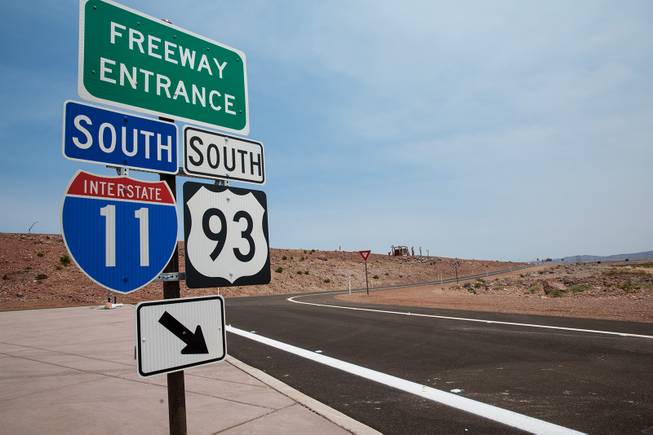
For now, Interstate 11 is a 15-mile divided highway from Henderson to near the Nevada-Arizona border, bypassing Boulder City, shown here in this 2018 file photo. But if supporters in Nevada and Arizona have their way, the road one day will move traffic from the Arizona-Mexico border to Reno and beyond, linking Las Vegas and Phoenix.
Tuesday, Oct. 15, 2019 | 2 a.m.
The first portion of Interstate 11 opened around a year ago, a crucial step toward the eventual construction of a freeway linking the Mexican border near Nogales, Ariz., to Northern Nevada and potentially Canada via Phoenix and Las Vegas.
As of now, the only existing portion of I-11 is a 15-mile stretch of divided highway that runs from Henderson to the Nevada-Arizona state line. Further construction on the project is years away, as government agencies in both Nevada and Arizona develop environmental impact studies for possible routing.
“We need to undergo this (environmental study), looking at all these pluses and minuses,” said Tony Illia, a spokesperson for the Nevada Department of Transportation.
The environmental assessment in Nevada, which is expected to take three years to develop and cost $4.75 million, is focused on the best route to connect U.S. 93 north of Nevada’s border with Arizona to the Kyle Canyon interchange on U.S. 95 in northwest Clark County. The study will consider issues including safety, infrastructure condition, traffic congestion, freight movement, economic vitality and environmental sustainability, Illia said in an email.
The selected route will likely create economic opportunities, Illia said.
“Wherever infrastructure goes, development usually follows and investment follows,” he said.
There are three preliminary routes for the interstate to continue throughout the Las Vegas Valley — attaching to the Las Vegas Beltway, continuing onto Interstate 515/U.S. 95 or building a new eastern connection to the existing I-11.
North of the valley, the I-11 route essentially will follow U.S. 95, Illia said. The existing portion of the road, he said, has been averaging 20,000 vehicles daily, with 18% of that number coming from tractor-trailer traffic.
Arizona also is developing a route for the interstate. The plan there is to follow the existing U.S. 95 corridor from Wickenburg, Ariz., to the Arizona-Nevada border north of Kingman, Ariz. The stretch between Nogales and Wickenburg, however, is still in the planning stages.
The Arizona Department of Transportation has identified three routes for that stretch, with varying levels of new and existing highways being used.
Arizona Gov. Doug Ducey is a proponent of the project, though support for the project is not uniform throughout the state. Environmentalists and some politicians, including the entire Tucson City Council, oppose the project.
Money, Illia said, is also an issue.
The costs for the stretch from Nogales to Wickenburg have been estimated between $3.1 billion and $7.3 billion by the Arizona Department of Transportation. As for the stretch from Las Vegas to Reno, Illia said it was "too early” to give a cost estimate.
As the two states continue weighing the possible routes, they're also facing the prospect of less transportation-related money from the federal government under a law that's slated to go into effect in 2020.
A provision in the Fixing America’s Surface Transportation Act would rescind $7.6 billion that had been earmarked for the federal highway program. Nevada's share of that is estimated around $50 million.
Sen. John Barasso, R-Wyo., who has introduced legislation to overturn the provision — set to go into effect in July 2020, said the rescission would affect every state’s ability to plan, build and repair needed roads and bridges.
Nevada's U.S. Sens. Catherine Cortez Masto and Jacky Rosen, in a letter to congressional leaders, protested the rollback.
“While every state would be affected, Nevada is always at significant peril if infrastructure funding is reduced because our population continues to grow faster than any other state. Funds are crucial because not only do we have to repair and maintain our existing roads, bridges and transit operations, the state must also continue to build new infrastructure to keep up with the needs of incoming residents, including accounting for the vital future Interstate 11,” the senators wrote.
